1930s Women’s Fashion
The 1930s were a time of transformation in 1930s Women’s fashion marked by a return to elegance and practicality. This era saw a shift from the carefree styles of the previous decade to a more refined approach, influenced heavily by Hollywood’s golden age. As economic challenges loomed, fashion became a means of expression and resilience, balancing glamour with the realities of the time.
Key Fashion Trends of the 1930s
Bias cuts and natural waists took center stage in 1930s fashion. Daywear featured cinched waistlines and ankle-skimming skirts. The 1930s silhouette echoed a mature femininity, with dresses gliding to mid-calf lengths that showed structure yet fluidity. Silks and satins were popular, thanks to their ability to cling and drape elegantly.
Hollywood’s influence was unmistakable in 1930s Women’s fashion. Movie stars were the icons every woman aspired to emulate. Actresses donned luxurious creations that blurred the lines between costuming and high fashion. Bias-cut gowns became essential in wardrobes, moulding sensational curves that mirrored those of silver screen darlings.
Daytime looks in 1930s Women’s fashion didn’t escape the Hollywood allure. Tweed suits with structured jackets and blouses boasting fluttering sleeves turned heads. Thanks to cheaper fabrics like rayon, every woman could indulge in a touch of glamour without breaking the bank.
Prints and patterns began to pop. Geometric marvels and floral flourishes dominated the fabric scene. Earthy tones held sway in daywear, but come evening, it was all champagne hues and inky blacks.
The return of the waist was undeniable. Garments hugged waists and flared at the bottoms, offering a truly ladylike silhouette. Power shoulders emerged through puffed and butterfly sleeves, striking a balance of strength and gentility.
In sports, women were carving out their niche with sportswear that blended practicality with style. Wide-leg trousers grew in prominence, encompassing the laid-back yet polished look women strived for in outdoor leisurely pursuits. The beach scene blossomed with playful swimwear.
Accessories played an important part, with oversized hats, gloves, and compact handbags adding charm. Fur, real or faux, draped across shoulders when the mercury dipped, adding an aura of opulence even when pockets were empty.
That’s 1930s fashion—an era that balanced elegance and practicality, finding harmony between the hardships of the Great Depression and the yearning for a glamourous escape.
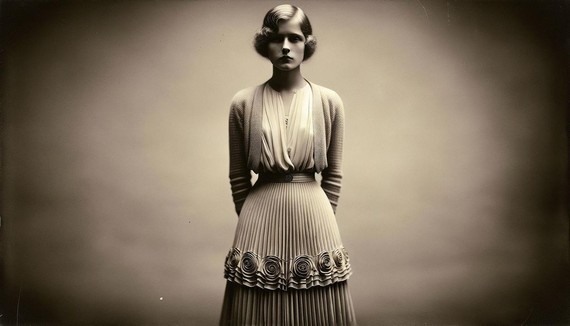
A woman wearing a typical 1930s dress with a cinched waist and mid-calf length skirt
Influence of Hollywood on 1930s Fashion
As Hollywood’s golden age flourished, it became a veritable incubator for 1930s Women’s fashion innovation. The cinema was more than just a temporary escape during tough economic times; it was a style bible that dictated trends to eager audiences.
Film stars were the celebrities of their day, wielding influence far beyond the studios. Actresses like Katharine Hepburn, Bette Davis, and Vivien Leigh became unofficial trendsetters. Ladies everywhere coveted the sleek evening gowns and sophisticated daywear that their favourite stars wore on screen.
Gowns crafted by Hollywood’s costume designers often carried an appealing twist. Rather than mere replicas of Parisian fashion, these creations featured exaggerated silhouettes, opulent embellishments, and contemporary flair. The famous Adrian-designed dress worn by Joan Crawford in “Letty Lynton”, with its dramatic ruffled sleeves, became a sensation, selling copies by the thousands.
Off-screen, actresses embodied the 1930s silhouette in practical and wearable ways. High-waisted trousers, popularised by the likes of Hepburn, offered women a chic alternative to skirts and dresses. The sharply cut suits found their way into offices and high society events, symbolising a burgeoning liberation and sophistication among women.
The influence of Hollywood in 1930s Women’s fashion extended beyond clothing. Film magazines offered insights on adopting the hairstyles and makeup of adored film stars. Women recreated the captivating allure of Hollywood beauty, their everyday lives infused with a touch of film star magic.
Accessorising à la Hollywood became an art form of its own. Coquettish hats, gloves, and other accessories resonated with this era of sophisticated charm.
In essence, Hollywood served as a transformative force in 1930s Women’s fashion. As fans looked up to their on-screen idols, they embraced and emulated, turning every day a little more glamorous than the last.
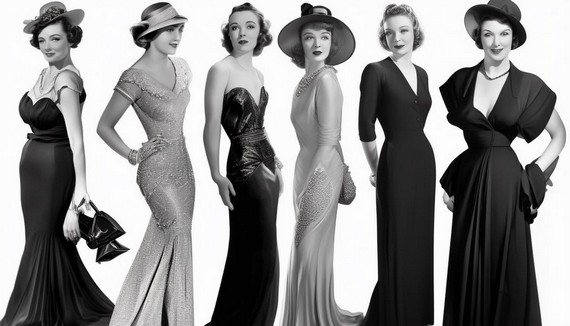
A montage of 1930s Hollywood actresses in glamorous gowns and suits
1930s Women’s Fashion – Everyday and Evening Wear
In 1930s fashion, everyday clothing and evening attire marked a deliberate transition from the routine to the resplendent. Everyday wear was dictated by practicality, yet it did not forgo elegance. Women often turned to readily available materials like cotton and rayon for their day-to-day outfits. These garments were designed with flattering cuts that echoed the decade’s emphasis on the waistline. The tea dress emerged as a staple, modestly cut with midi hemlines and often adorned with subtle patterns.
For work or social engagements, suits offered a refined allure with their sharp jackets and smart skirts, often accessorised with a string of pearls or a simple brooch. Hats remained fashionable for daily outings but leaned towards the understated.
Evening wear in 1930s Women’s fashion however, transformed entirely. Gowns were often bias-cut, allowing materials to drape and contour the body, creating a silhouette both alluring and dignified. Necklines plunged, and backs were provocatively revealed in daring cuts. Sparkling embellishments and intricate beadwork adorned these gowns, amplifying their extravagance.
Economics subtly wove its influence through these disparities. Daily wardrobes were crafted from robust fabrics designed to endure whilst still flattering. Evening attire reflected a defiant opulence amidst the Great Depression—a desire to escape the ordinary and immerse in a world of fantasy.
Thus, the fashion story of the 1930s was a testament to resilience and creativity. By day, women inhabited their roles with grace, embodying practicality without sacrificing style; by night, they transcended into icons of cinematic elegance.
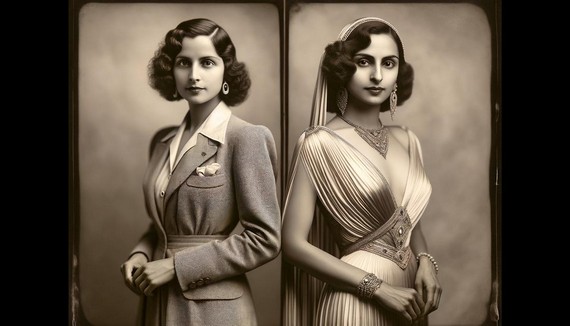
Side-by-side comparison of 1930s daywear and evening wear on two women
Accessories and Makeup
Accessories played a pivotal role in shaping the quintessential 1930s Women’s fashion aesthetic. Hats, with their variety of shapes and sizes, were essential elements. Whether it was a tilt hat perched over a neatly coiffed bob or a wide-brimmed straw hat complementing a flowing summer dress, these headpieces added personality and flair.
Gloves were another indispensable accessory, adding a touch of elegance to any ensemble. Be it short leather gloves for daytime or long, luxurious fabrics for evening affairs, they completed the look with understated grace.
Jewellery often spoke louder than words. Pearls and simple strings of beads were daytime favourites. By night, dramatic pieces such as oversized brooches, glistening bangles, and jewelled back necklaces were chosen to elevate evening wear.
Makeup served as the final touch in completing the 1930s Women’s fashion look. The era saw an evolution from the stark contrasts of the 1920s to more refined and varied tones. Complexions were crafted carefully with powders for softly luminous skin, offset by lightly blushed cheeks.
Lipsticks in rich tones such as deep reds and alluring berries were favoured, lending sophistication to the lips. Eyebrows saw a radical transformation, plucked thin and drawn into elegant arches. Eye makeup embraced shadows in muted colours such as greys and taupes, enhancing the natural contour of the eyes.
The 1930s Women’s fashion makeup ethos was akin to painting a picture; each woman had her palette that complemented her clothing, accessories, and persona. This interplay of accessories and makeup ensured that the women of the 1930s carried both history and hope upon their shoulders—a legacy of grace that transcended any simplicity in fabric.
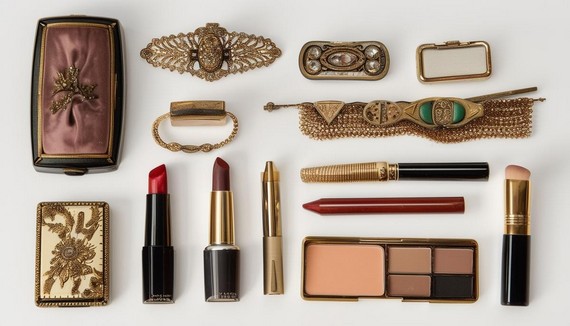
A collection of 1930s accessories and makeup items
Impact of Socio-Economic Factors
Economic hardship deeply shaped the fashion landscape of the 1930s, as the Great Depression cast its shadow across society. 1930s Women’s fashion became an arena not simply for expression of creativity, but one marked by practicality and resourcefulness.
In response to the economic climate, clothing production underwent pivotal changes. The era heralded the rise of ready-to-wear fashion, dramatically lowering clothing prices and making fashion more accessible. With affordable, ready-made garments now available in department stores, 1930s fashion was no longer a preserve of the wealthy.
The advent of man-made fabrics such as rayon, along with innovations like the zip, further contributed to the accessibility of fashion. These materials and technologies allowed producers to create stylish yet economical clothing. The introduction of rayon—a less expensive alternative to silk—was particularly transformative, offering a semblance of luxury while remaining economically feasible.
Mail-order catalogues and shopping models that encouraged the purchase of demi-tailored clothes—garments partially completed with only the simplest finishing touches required by the wearer—started to dominate 1930s Women’s fashion. These garments struck a pragmatic balance, catering to those who desired custom-made clothing but whose budgets dictated otherwise.
The socio-economic pressures of the time led to a growing trend of recycling and repurposing existing garments. Creative home-sewing techniques flourished, fuelled by a shared determination to make do and mend.
The Great Depression also encouraged a retreat from extravagant ostentation towards subtler forms of expression. While the glamour of evening attire remained a beloved escape, daytime 1930s Women’s fashion leaned towards resilience and practicality.
Despite the financial strain, 1930s Women’s fashion remained an essential form of self-expression—a necessary art form that provided not just clothing but a vital means of hope and dignity during trying times. Women of the 1930s were thus able to handle the challenges of the economic landscape with ingenuity, using fashion as a tool not only for survival but also for celebration.
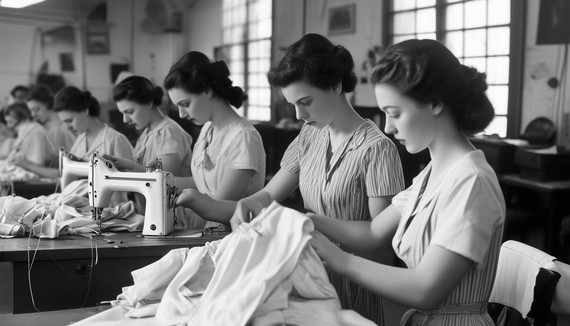
Women sewing and altering clothes to adapt to the economic challenges of the 1930s
Fashion in the 1930s was a testament to creativity and adaptability, reflecting both the aspirations and challenges of the era. It was about finding beauty in simplicity and elegance in everyday life, offering a glimpse of hope and dignity amidst adversity.
References:
- Jones K. Sporting Fashion: The Definitive Sourcebook. New York, NY: ASU FIDM Museum; 2021.
- Mendes V, de la Haye A. 20th Century Fashion. London: Thames & Hudson; 1999.
- Steele V. Fashion in the 1930s. In: The Berg Companion to Fashion. Oxford: Berg Publishers; 2010.
1930s Women’s Dresses
Hollywood’s golden era in the 1930s was a period where cinema and fashion intertwined seamlessly. The silver screen wasn’t just a source of entertainment; it was a beacon of style, influencing wardrobes far beyond the confines of the film studios. As actresses donned glamorous 1930s Women’s dresses and chic suits, audiences found themselves captivated by the allure of these sartorial choices, which offered both an escape and inspiration during challenging times.
Influence of Hollywood on 1930s Fashion
Hollywood stars like Jean Harlow and Greta Garbo were more than just actresses; they were fashion trendsetters. Their on-screen presence showcased 1930s Women’s Dresses with lavish evening gowns and stylish suits that women eagerly sought to emulate. The 1930s fashion scene was filled with elegance, featuring silk and satin creations molded to the body with the revolutionary bias cut.
Cinema’s influence extended far beyond the studio lots, with films essentially serving as unofficial fashion magazines. The allure of Hollywood glamour provided an escape from the challenges of the Great Depression. Celebrities endorsing sewing patterns allowed viewers to recreate iconic 1930s Women’s Dresses at home, making silver screen style more accessible.
Even child star Shirley Temple’s curls and bright personality sparked a fashion trend, with young girls everywhere wanting to mimic her frilly dresses and tap-dancing shoes. The era saw innovations like the zipper and fabrics like rayon making fashionable clothing more available to the masses.
Designers like Coco Chanel and Elsa Schiaparelli also left their mark, blending practical sophistication in 1930s Women’s Dresses with Hollywood glamour. In essence, 1930s fashion saw Hollywood not just influencing style but reinventing wardrobes entirely, allowing everyday women to infuse a touch of cinematic magic into their lives.
Side-by-side comparison of Jean Harlow and Greta Garbo in iconic 1930s outfits, showcasing their influence on fashion trends
Key Features of 1930s Women’s Dresses
The 1930s marked a shift from the androgynous flapper styles to softer, more feminine silhouettes. The bias cut, pioneered by designers like Madeleine Vionnet, created garments that elegantly draped the body. Dresses embraced femininity with accentuated waistlines and delicate details.
- Sleeves became a focal point of creativity, featuring puffed, butterfly, and banjo styles
- Shoulders were bold yet sophisticated, complemented by cinched waists
- Hemlines fell between mid-calf and ankle, often in flowing layers or tiers
Luxury fabrics like silk and satin were popular, but the rise of rayon offered a more affordable option for 1930s Women’s Dresses without compromising on style. The introduction of zippers made garments more accessible to ordinary women.
Color palettes ranged from muted pastels to rich jewel tones, with sophisticated art deco prints adding visual interest. Patterns included geometric designs, florals, and polka dots, suitable for both day and evening wear.
As the decade progressed, hemlines slightly rose, and A-line skirts hinted at 1940s trends. Throughout, the 1930s dress remained a symbol of refined femininity, balancing practicality with glamour.
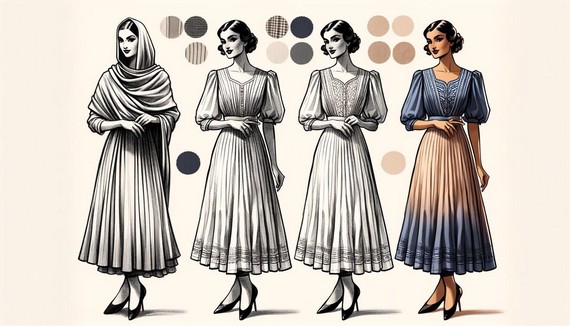
Illustration of a 1930s dress highlighting key features such as bias cut, puffed sleeves, and cinched waist
Accessibility and Affordability of 1930s Fashion
The 1930s saw fashion become more accessible and affordable, despite economic challenges. Innovations in materials and production methods played a crucial role in democratizing style.
Rayon, known as ‘poor man’s silk,’ emerged as a game-changer. This man-made fiber captured the look and feel of luxurious textiles at a fraction of the cost, allowing women from various backgrounds to embrace the decade’s elegant aesthetic.
The widespread adoption of zippers in 1930s Women’s Dresses simplified garment construction, reducing production time and costs. This innovation made fashionable clothing more attainable for the average woman.
Retailers like Sears capitalized on these changes, offering ‘semi-made’ outfits that required minimal sewing at home. This approach made stylish clothing more accessible to a broader audience.
Fashion became less about class distinction and more about personal expression. Women could now experiment with various styles, prints, and cuts previously seen only in magazines or films.
The synthesis of technological advancements and creative design allowed fashionable 1930s Women’s Dresses to meet both practical needs and aspirational desires. It affirmed that style need not be sacrificed for affordability, ensuring that the beauty of 1930s fashion was accessible to many.
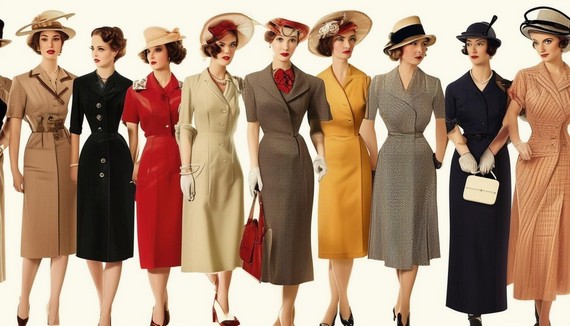
Scene depicting women of various social classes wearing similar stylish 1930s outfits, illustrating the democratization of fashion
Iconic Designers and Fashion Innovations
Coco Chanel and Elsa Schiaparelli were pivotal figures in 1930s Women’s dresses fashion, each bringing a unique perspective to the industry. Chanel was known for her timeless elegance, revolutionizing the little black dress and incorporating elements from men’s tailoring. Her use of jersey knits allowed for greater comfort and movement, aligning with the modern woman’s needs.
Schiaparelli took a more avant-garde approach, merging art and fashion through collaborations with surrealists. Her 1930s Women’s dresses designs featured whimsical elements like lobster prints and trompe l’oeil motifs, challenging conventional fashion norms.
“A girl should be two things: classy and fabulous” – Coco Chanel
Madeleine Vionnet’s introduction of the bias cut was a game-changer. This technique of cutting fabric diagonally against the grain created 1930s Women’s dresses garments that draped beautifully on the body, enhancing natural curves.
These designers didn’t just create clothes; they reshaped the landscape of fashion. Their innovations paved the way for future developments, influencing both high-end 1930s Women’s dresses and everyday fashion. Despite the economic challenges of the era, their work embodied creativity, elegance, and a forward-thinking approach to design.
Comparison of iconic designs by Coco Chanel and Elsa Schiaparelli, showcasing their distinct styles
1930s Women’s dresses – Daywear and Workwear Trends
The 1930s saw daywear and workwear evolve to meet the needs of increasingly active women. Fashion balanced practicality with elegance, adapting to changing social roles.
The two-piece suit became a staple, offering a blend of femininity and power. With its sharp lines, nipped waist, and padded shoulders, it conveyed sophistication suitable for both office and social settings. Tweeds and solid colors in classic shades were popular choices.
Shirt-and-skirt combinations provided versatile options for everyday wear. Romantic, frilly blouses paired with waist-accentuating skirts allowed for both functionality and style. These ensembles were ideal for various occasions, from work to casual outings.
Accessories played a key role in completing looks. Silk scarves, gloves, and berets added touches of elegance, while jewelry was chosen to balance simplicity and sophistication.
The fashion of this era reflected resilience and creativity. It empowered working women, proving that everyday attire could be both practical and stylish. The daywear and workwear of 1930s fashion didn’t just clothe; they made a statement about the changing roles and aspirations of women in society.
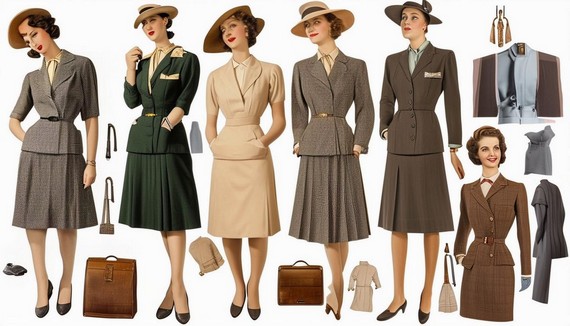
Collage of 1930s daywear and workwear outfits, featuring two-piece suits, shirt-and-skirt combinations, and accessories
In the 1930s, Hollywood’s influence on 1930s Women’s dresses in fashion was transformative. The glamour of cinema reshaped everyday style, allowing people to infuse their wardrobes with a touch of silver screen elegance. This era highlights how film can shape not just trends, but also personal expression, creating a lasting impact on fashion
References:
- Fiell C, Fiell P. Fashion: The Definitive History of Costume and Style. DK Publishing; 2021.
- Blackman C. One Hundred Years of Menswear. Laurence King Publishing; 2012.
- Finnane A. How to Make a Mao Suit: Clothing the People of Communist China, 1949–1976. University of Melbourne Press; 2018.
- Galambosova L. Elsa Schiaparelli: The Surrealist Fashion Designer. Daily Art Magazine. 2024.
1930s Women’s Accessories
1930s Women’s accessories played a pivotal role in shaping personal style in 1930s fashion. From hats to handbags, each piece was a testament to the era’s charm and ingenuity, offering a glimpse into a time when elegance met everyday life with grace and creativity.
1930s Women’s fashion – Hats and Headwear
Hats in the 1930s balanced practicality with a touch of glamour. The cloche hat initially held its ground well into the early ’30s, but as time progressed, fashionistas embraced new styles.
Asymmetry became popular in 1930s Women’s accessories , with slouch hats taking center stage. Wide-brimmed straw hats were perfect for Sunday picnics, while Hollywood’s influence made hats symbols of allure and drama. Berets tipped just so and fedoras worn with a nonchalant tilt became fashion statements.
These hats had to balance style with utility. Felt fabrics offered warmth for cooler weather, while light summer straw was ideal for picnics and pleasantries. Hats coordinated expertly with a woman’s ensemble, matching gloves, shoes, or even lipstick shade.
Each hat became an extension of a story, blending narrative with necessity, and marking the 1930s as a time when headwear was a fashion symphony.
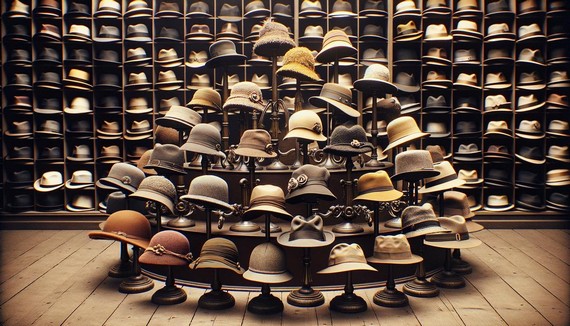
A display of various 1930s hat styles including cloche hats, wide-brimmed straw hats, and fedoras
Gloves and Their Role
In 1930s Women’s fashion, gloves were graceful extensions of one’s personality. They dressed hands in fabrics that narrated their own stories, elevating outfits while acting as both a shield and a flourish.
During the day, short gloves, no longer than the wrist, typically accompanied chic daywear. Simple cotton or kid leather gloves added a touch of class while maintaining practicality. Pastel hues might echo the bloom of spring, accentuating floral day dresses.
As evening descended, gloves transformed into elongated whispers of elegance. Elbow-length silk or satin gloves were de rigueur, creating a mesmerizing interplay of light and shadow at candlelit soirees.
Gloves highlighted personality while adhering to decorum. Consider the following glove choices and their implications:
- Neutral tones: Suggested understated sophistication
- Vibrant reds: Spoke of bold confidence
- Embellishments: Buttons, lace trims, or delicate embroidery added intricacy
Serving as a bastion of propriety, gloves enabled women to indulge in social interactions while maintaining a decorous front. Whether complemented by a jaunty hat or paired with a bias-cut dress, gloves anchored outfits with panache, underscoring the 1930s vaudeville of charm and charisma.
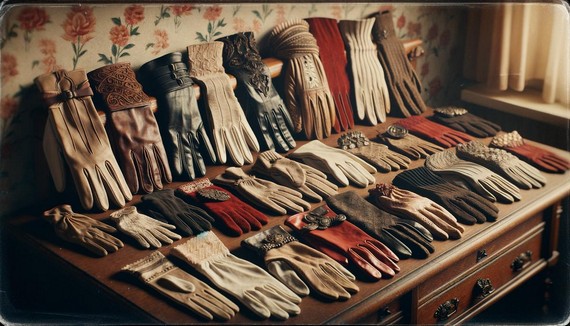
A collection of 1930s gloves in various styles and lengths, from short daytime gloves to long evening gloves
1930s Women’s fashion – Jewellery Trends
With 1930s Women’s accessories, jewellery offered a shimmer of optimism amid the Great Depression. Costume jewellery came into its own, offering elegance with a touch of whimsy without the heavy price tag. Coco Chanel championed mixing faux with genuine pieces, emphasizing that style was about expressing personality rather than wealth.
Art deco influences were prominent in 1930s Women’s accessories, with designs echoing the geometric boldness of contemporary architecture. Jewellery embraced angular shapes, striking contrasting colors, and intricate motifs inspired by ancient cultures.
Popular jewellery items of the era in 1930s Women’s accessories included:
- Brooches: Ornamented with enamel or faceted stones
- Clip-on earrings: Allowed women to change their look frequently
- Necklaces: Exuded drama with strings of chunky beads or faux pearls
- Bracelets: Often layered for a gentle blend of color and sheen
- Rings: Captured the art deco spirit, transforming fingers into miniature canvases
Each jewellery piece in 1930s Women’s accessorieswas a testament to fashion’s resilience, allowing every woman the chance to be the heroine of her own story.
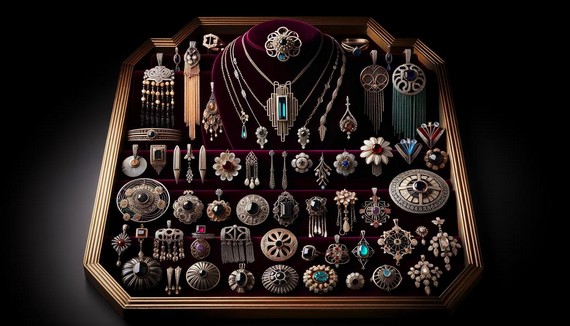
A selection of 1930s art deco jewellery including brooches, clip-on earrings, necklaces, bracelets, and rings
1930s Women’s fashion – Handbags and Shoes
Handbags and shoes were essential components in 1930s Women’s accessories for a 1930s fashion wardrobe, balancing style with functionality. Handbags served as a toolkit of daily necessities within a stylish shell.
Leather was the primary material for handbags, offering durability and sophistication. Designs favored rectangle or square shapes, allowing for easy organization of essentials. Clasp or snap closures ensured items remained secure. Decorative elements like subtle embroidery, enamelled clasps, and art deco motifs offered individuality within 1930s Women’s accessories period fashion.
Shoes in 1930s Women’s accessories combined practicality with elegance. Popular styles included:
- T-straps
- Mary Janes
- Brogues
These were crafted to withstand urban pavements and ballroom dances alike. Leather and suede were favored for durability and comfort. Two-tone brogues caught the eye with contrasting panels, while T-strap shoes added a feminine touch in 1930s Women’s accessories to various ensembles.
Heels in 1930s Women’s accessories were slightly lower and broader than in the 1920s, supporting the feet of industrious women without forgoing style. This compromise ensured women could stride confidently through life’s challenges while maintaining their fashion sense.
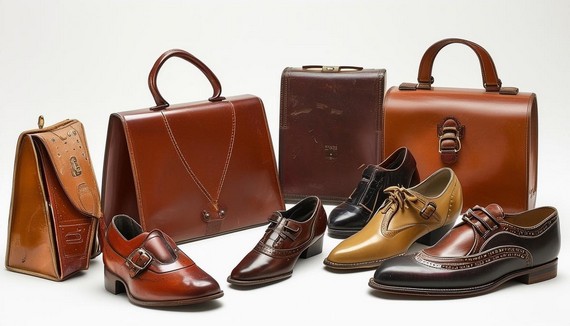
A collection of 1930s handbags and shoes, featuring leather rectangular bags, T-strap shoes, Mary Janes, and brogues
Influence of Hollywood
Hollywood in the 1930s was the heartbeat of 1930s Women’s fashion inspiration, particularly for accessories. Film stars like Greta Garbo and Marlene Dietrich became unintentional style ambassadors. When a starlet adorned a particular accessory on screen, it quickly gained popularity among the public.
The beret, once a simple cap, soared in popularity after gracing the heads of screen sirens. Sunglasses took on an air of mystery and allure, with large, glamorous frames becoming a subtle nod to Hollywood’s promise of sophistication.
Jewellery on screen in 1930s Women’s accessories, from pearls to rhinestones, inspired women to seek similar opulence through affordable costume pieces. Handbags, particularly clutches with intricate beadwork, found favor as women emulated the red-carpet glamour they admired.
Hollywood’s influence on 1930s Women’s accessories in 1930s Women’s fashion transformed accessories into extensions of glamour-dripped stories. A hat was no longer just a hat, nor a bracelet merely a bracelet; they became part of a narrative crafted in movie houses and adopted in personal style.
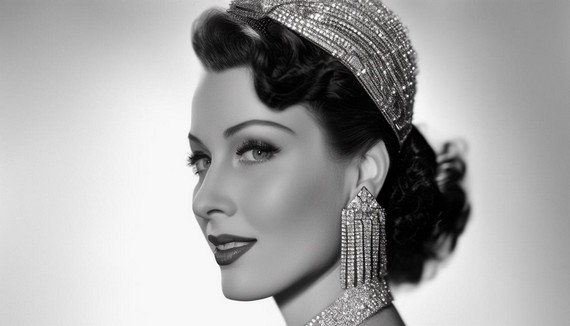
A glamorous 1930s Hollywood actress wearing iconic accessories inspired by the era’s film stars
Reflecting on 1930s fashion, it’s clear that 1930s Women’s accessories were expressions of individuality and resilience. Each piece told a story of hope and sophistication, leaving an enduring mark on fashion’s rich history.
References:
- Baylor University. The History of Homecoming Mums. Baylor University Archives.
- Vintage Dancer. 1930s Evening Gowns, Dresses and Formal Wear History.
- Fashion History Timeline. 1930-1939.
- V&A Museum. Fashion in the 1930s.
- The Met. Art of the Twenties: The Decade of Glamour.
1930s Women’s Hairstyles
The 1930s marked a period of transformation in 1930s women’s hairstyles, blending elegance with creativity. This era saw the rise of iconic styles that balanced waves and curls, creating looks that were both sophisticated and artistic.
Key 1930s Hairstyle Trends
The 1930s was a defining decade for women’s hairstyles in 1930s Women’s fashion, centered on a balance of waves and curls. Finger waves were at the forefront, creating sleek and sculpted looks that swooped in stylish elegance. These waves, achieved through styling with fingers and combs, were often adorned with bobby pins.
Pin curls offered soft volume and intricate patterns in 1930s Women’s hairstyles. Women wound sections of damp hair to create tight curls, often set with pins overnight. The result was a charming cascade of curls framing the face.
The bob remained popular among 1930s Women’s hairstyles, but evolved with added flair and length. Celebrities like Greta Garbo wore it voluminous and wavy. By decade’s end, longer hairstyles gained ground, often styled to appear short, giving rise to the faux bob.
Hollywood starlets like Vivien Leigh flaunted glamorous waves cascading below the shoulder, marking a shift toward longer locks. These waves were carefully sculpted into glossy layers.
1930s Women’s Fashion – Accessories and Influences
- Hair clips glimmered with jewels and rhinestones
- Combs were tucked into curls
- Hats added an element of allure, from tiny fascinators to grand designs
The influence of screen sirens was significant on 1930s Women’s hairstyles. Jean Harlow’s platinum blonde tresses became iconic, while Carole Lombard’s fringe styles provided 1930s Women’s fashion inspiration to many.
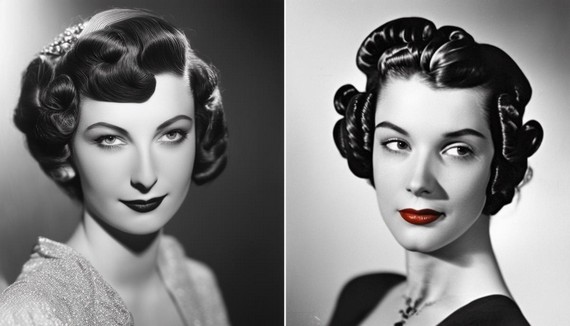
Side-by-side comparison of a woman with finger waves and another with pin curls, both popular 1930s hairstyles
Styling Techniques and Tools
Creating these iconic 1930s Women’s hairstyles required both skill and patience. Pin curling was a favored method, where women twisted small sections of damp hair into tight coils, securing them with pins. This process, often done at home and left to set overnight, resulted in beautifully defined curls by morning.
Marcel waving, named after the French hairdresser François Marcel, involved using a heated iron to press hair into soft yet structured waves. Precision was crucial to create a series of ridges that imparted a sophisticated, wavy texture.
Bobby pins were indispensable for maintaining intricate 1930s Women’s hairstyles, either nestled discreetly into curls or used as decorative elements. Their simple design belied their essential nature in achieving lasting styles in 1930s Women’s fashion, without weighing down the hair.
“If you’ve had success with a characteristic coiffure, you should hold on to it for dear life.”
Professional hairstylists were sought-after in the 1930s for their ability to transform tresses into desired looks. However, mastering these styles at home wasn’t out of reach. Women spent time learning hairstyling, reading guides, and sharing tips with friends.
The upkeep for these 1930s Women’s hairstyles was no small feat. Regular maintenance was essential, with adjustments needed to keep waves intact and curls bouncy. Many found themselves revisiting hairdos throughout the day to ensure every detail remained perfect—a testament to the effort and dedication that 1930s Women’s fashion style demanded.
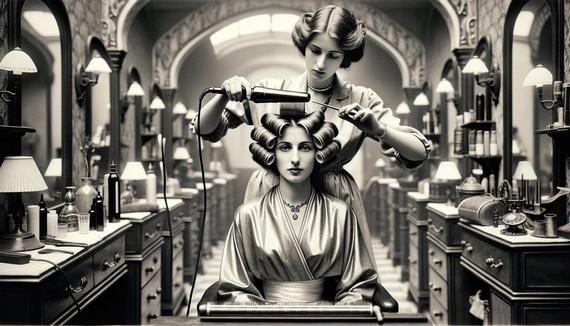
Hairdresser demonstrating the Marcel waving technique on a client in a 1930s salon setting
1930s Women’s hairstyles were expressions of individuality and style. Each wave and curl captured an era where glamour was woven into everyday life.
References:
- Van Wyck C. Hair Line Can Transform You – 1930s beauty report. Glamourdaze. 1930.
- Van Wyck C. 1930s Hairstyle Report. Glamourdaze. 1930.
- Thomas J. The perm: from conception to current day. Glamourdaze. 2020.
Related posts:


